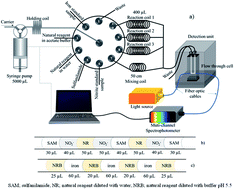Dual determination of nitrite and iron by a single greener sequential injection spectrophotometric system employing a simple single aqueous extract from Areca catechu Linn. serving as a natural reagent†
Abstract
Dual determination of nitrite and iron was proposed by using a single greener sequential injection (SI) spectrophotometric system employing a simple single aqueous extract from Areca catechu Linn. The extract served as a natural reagent to replace N-(1-naphthyl)ethylenediamine (NED) of the Griess reagent with nitrite and 1,10-phenanthroline with iron. The color products possessed analytical wavelengths at 430 and 560 nm, respectively. Conditions for the SI procedure were optimized using a univariate experimental design. Calibration ranges were up to 5.0 mg L−1 and 10.0 mg L−1 with limits of detection (LODs) of 0.04 mg L−1 and 0.05 mg L−1 for nitrite and iron(III), respectively, and relative standard deviations (RSDs) being less than 3%. Recoveries of spiked standard nitrite and iron(III) at 0.3 mg L−1 and 0.5 mg L−1 in water samples were 88 to 104% and 84 to 109%, respectively. The developed method successfully achieved dual determination of nitrite and total iron agreeing at a 95% confidence level with the reference methods of the conventional Griess assay and flame atomic absorption spectrometry (FAAS), respectively. The proposed method utilized locally available material from plants and serves the UN-SDGs.



 Please wait while we load your content...
Please wait while we load your content...